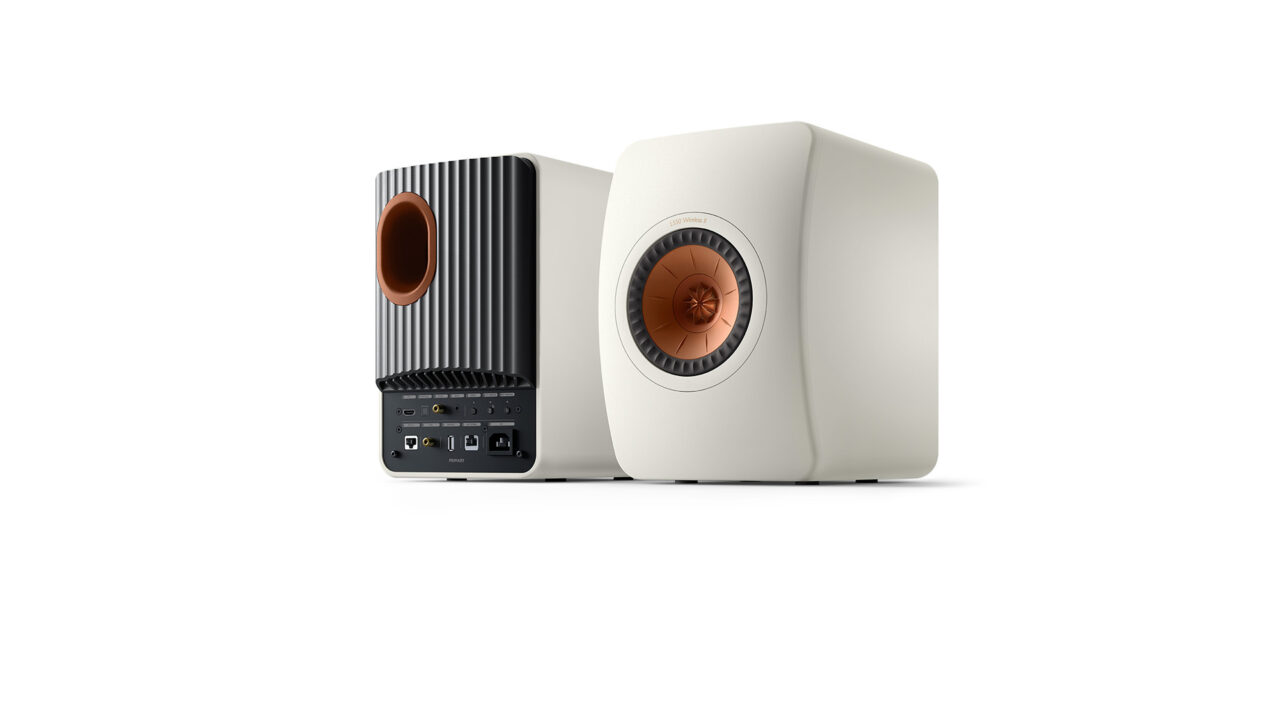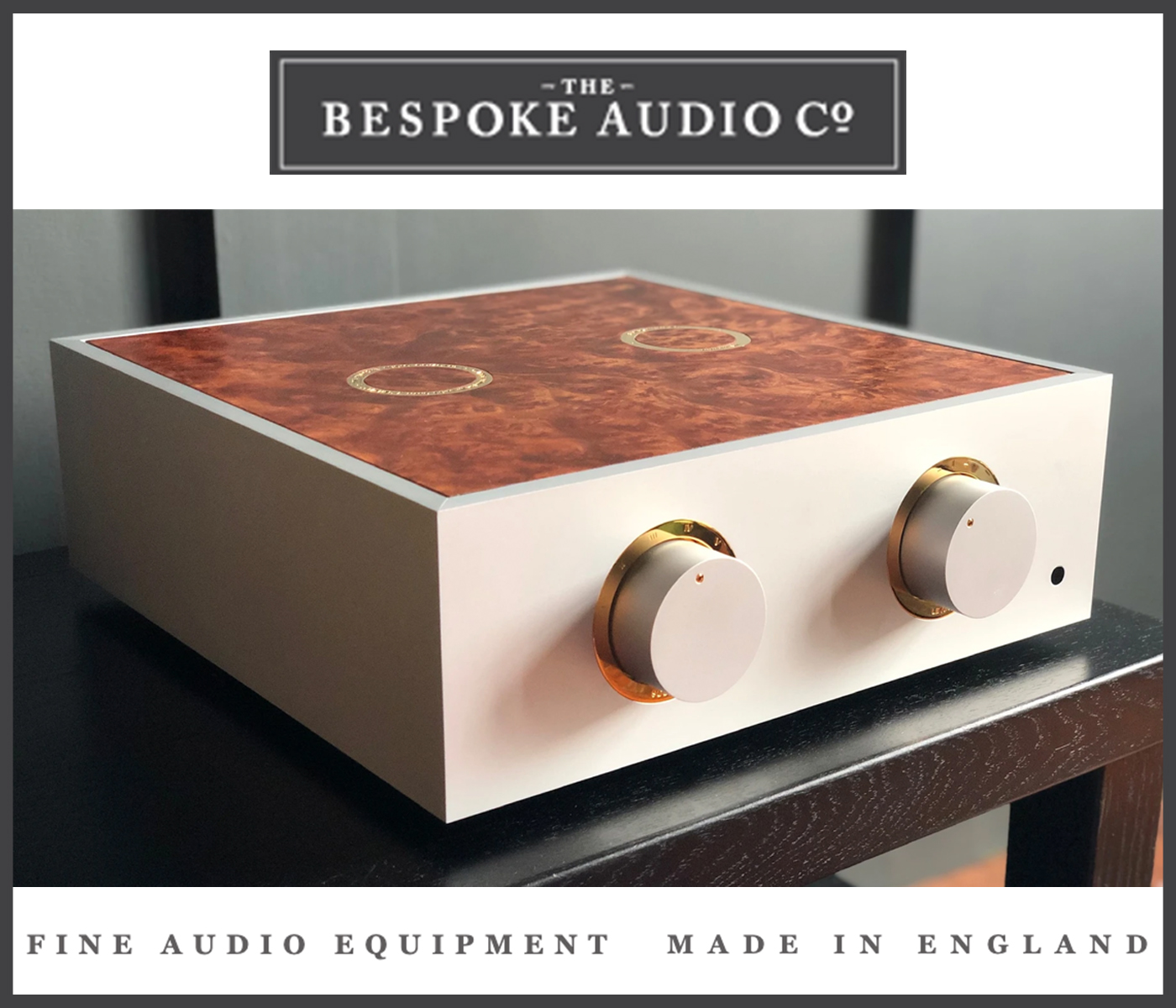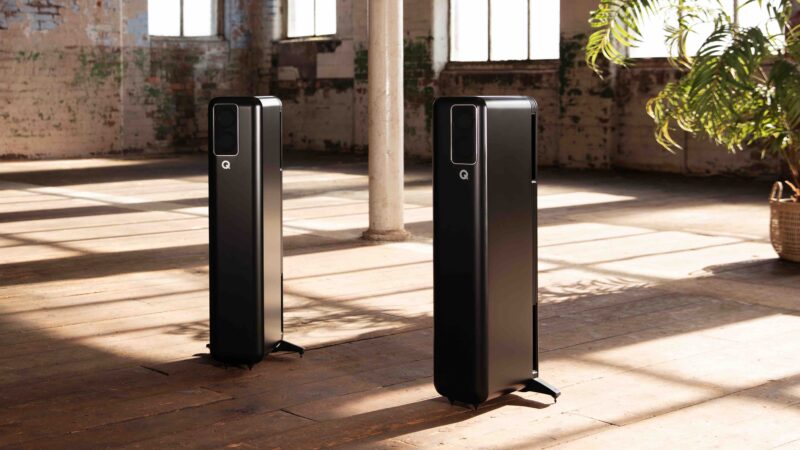KEF’s LS50 passive standmount loudspeaker is something of a legend in hifi circles, so I was intrigued to attend the launch of the LS50 Wireless active speaker system when it was first announced back in 2016. The press event was held at the inaugural Indulgence Show (since rebranded to the Festival of Sound Show) hosted at the Novotel in Hammersmith to an expectant crowd of fellow hifi journalists eager to learn about a new truly active speaker system for the domestic market.

KEF’s second-generation active speaker system in mineral white with copper-coloured 12th iteration Uni-Q speaker driver array
Before the LS50 Wireless the active speaker market tended to be focused on the pro-sector, with active designs carrying out duties in recording studios and mastering suites, for example. For domestic consumers there were ‘lifestyle’ powered-speakers where the stereo amplifier was housed inside one of the cabinets that drove itself and a partnering passive speaker linked via an umbilical cable. Unlike pro-sector models, these were often pretty lo-fi designs and failed to capture the sensibilities of home audiophiles.
The LS50 Wireless heralded a big step forward for the truly active speaker system market, not least because both cabinets were fitted with individual amplifiers to power the mid/bass and tweeter drivers of KEF’s Uni-Q speaker array. What’s more, the milestone speaker system integrated wi-fi connectivity for hi-res music streaming from services such as Qobuz and Tidal, and Bluetooth connectivity was also incorporated to attract more mainstream audiences that were less bothered by hi-res formats and simply wanted to stream in whatever quality was available from a portable device to a decent-sounding speaker system.
What’s new?
Priced at £2,250, which is an increase of £250 on the original LS50 Wireless, KEF says its Wireless II is better in every respect and offers improved sound with greater connectivity and usability. Judged on the system’s arrival and initial installation impressions on setting up in my living room, I wouldn’t disagree.
Connectivity standards have changed a lot since the introduction of the first generation Wireless and this next-gen version brings streaming capabilities bang up-to-date. KEF says it has spent three years improving the built-in amplification too, which is now rated at a total power output of 380W per speaker – 280W of Class AB amplification chosen for its wide bandwidth to the mid/bass driver and 100W of Class D amplification to the tweeter.
The KEF Connect app streamlines the installation procedure and source resolution is improved to support PCM 24-bit/384kHz (including MQA) and DSD256. It’s important to note, however, that resolutions are automatically downsampled to 24-bit/192kHz when connected via the supplied Ethernet cable linking the two speakers together and 24-bit/96kHz when linking the speakers via wi-fi.
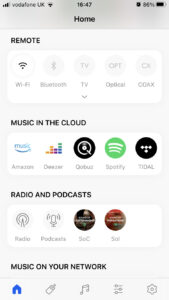
Control and connectivity have been improved and there’s greater support for streaming services, too
Wireless streaming protocol support includes AirPlay 2, DLNA, Chromecast, Bluetooth 4.2 and is set to offer full Roon Ready support via a software update coming soon. Streaming service support now extends to Qobuz, Tidal, Amazon Music, Deezer, Spotify Connect, Internet Radio and Podcasts as well as the ability to stream directly from native apps. Automatic firmware updates ensure streaming apps are always the latest versions.
Digital Signal Processing (DSP) has also been updated with improvements to signal flow and protection modes to safeguard the speaker from misuse without impacting on sound quality. An HDMI port has also been incorporated with ARC (Audio Return Channel) protocol to power the system on when the TV is activated, making the LS50 Wireless II a practical alternative to a soundbar where the speakers can be placed either side of a screen. TV sound can be controlled either by the set’s remote, KEF Connect app or supplied remote handset.
Uni-Q developments
Acoustic developments have also been made to take KEF’s already impressive Uni-Q driver array technology even further. Now in its 12th iteration and under the expert eye (and ear) of KEF’s head of research and development, Jack Oclee-Brown, the latest Uni-Q version includes the company’s Metamaterial Absorption Technology (MAT) – a complex material in a labyrinth structure – developed to improve rearward sound absorption and reduce midband total harmonic distortion (THD).
Little has changed in terms of the physical look and feel from the original LS50 Wireless. The Wireless II retains the bowed front baffle and I particularly like the look of the copper-coloured Uni-Q driver cone found on the carbon black and mineral white finish options. It’s also available in titanium grey and there’s a crimson red special edition too.
The speaker cabinets measure 305 x 200 x 311mm (HxWxD) and weigh around 10kg each. The Primary speaker contains much of the system’s external connectivity including digital coaxial, Toslink and the aforementioned HDMI port, and it can be configured during set up to be either the left or right stereo speaker, depending on what works best for your particular room layout.
At the back of both speakers there are sizeable heatsinks to help dissipate any internal heat. A bass reflex port aids the LS50’s bass output. On the top of the Primary speaker, there’s a useful arrangement of responsive touch controls for those times when you’re not able to get to the Connect app on your smart device quickly enough or you can’t locate the remote handset. Both are scenarios that came up during my time with the Wireless II during the review period.
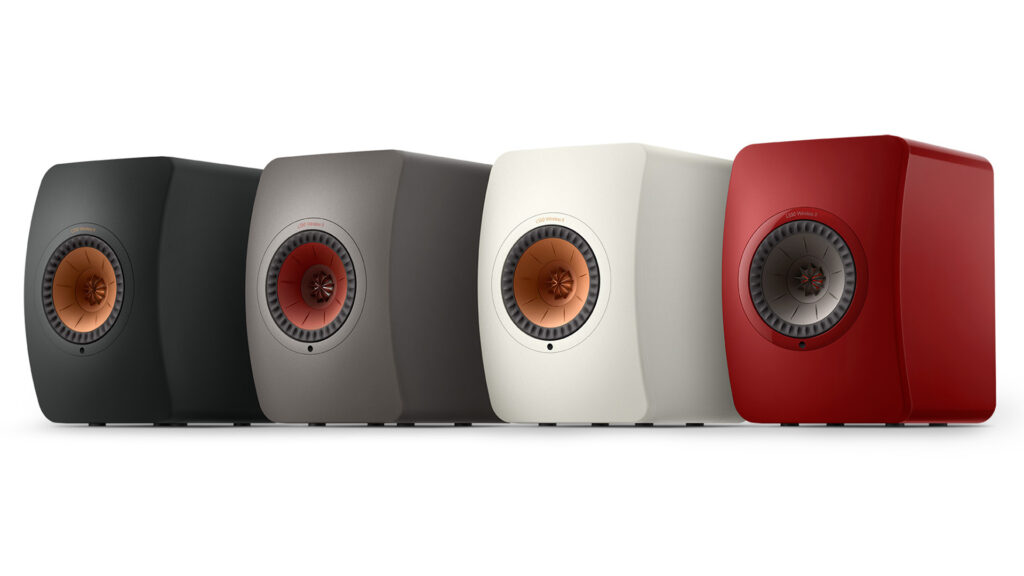
Standard colour finishes include carbon black, titanium grey and mineral white. A special edition in crimson red is also available
Build and setup
Build quality is solid and everything feels impressively well thought out. The system is nicely packaged and the quick start guide is simplicity its self – once I had each speaker powered up to a mains power socket, connected the system via Ethernet cable to my router and downloaded the Connect app to my iOS device, I was up and running in next to no time. I opted for the wi-fi to link the left and right speakers together (maxing out at 24-bit/96kHz) to avoid trailing an Ethernet cable between the two.
As a fully integrated streaming music system, there’s no need for any supporting components or sources to be added to the LS50 Wireless II, although there is provision to add a subwoofer via either one of the RCA connectors located at the back of each of the speaker cabinets.
I’m sure KEF would like customers to use its newly introduced £1,400 KC62 compact sub design as the perfect model to partner its LS50 series but for the latter part of my listening session, I hooked up REL’s S/510 sub-bass unit which was already in place in my living room and ready to go.
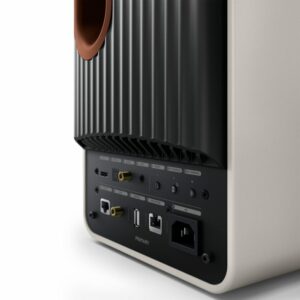
Digital input connectivity at the rear of the Primary speaker includes coaxial, Toslink and HDMI (with ARC)
Support stands
For optimum performance, each speaker cabinet is placed on a proper support stand to bring the Uni-Q drivers in line with my regular listening position on the sofa. KEF recommends using its own speaker stands of course and the purpose-designed S2 stands priced at £400 per pair are colour-matched to fit with the entire LS50 series and come in black, white or titanium grey standard finishes – royal blue and crimson red special edition finishes are also available.
For this review, however, I enlisted a pair of solid wood X50 speaker stands supplied by audiophile furniture maker Hi-Fi Racks. Finished in white satin and priced at £298.27, the supports work really well with the mineral white finish of the review sample and shaves a bit off the cost too.
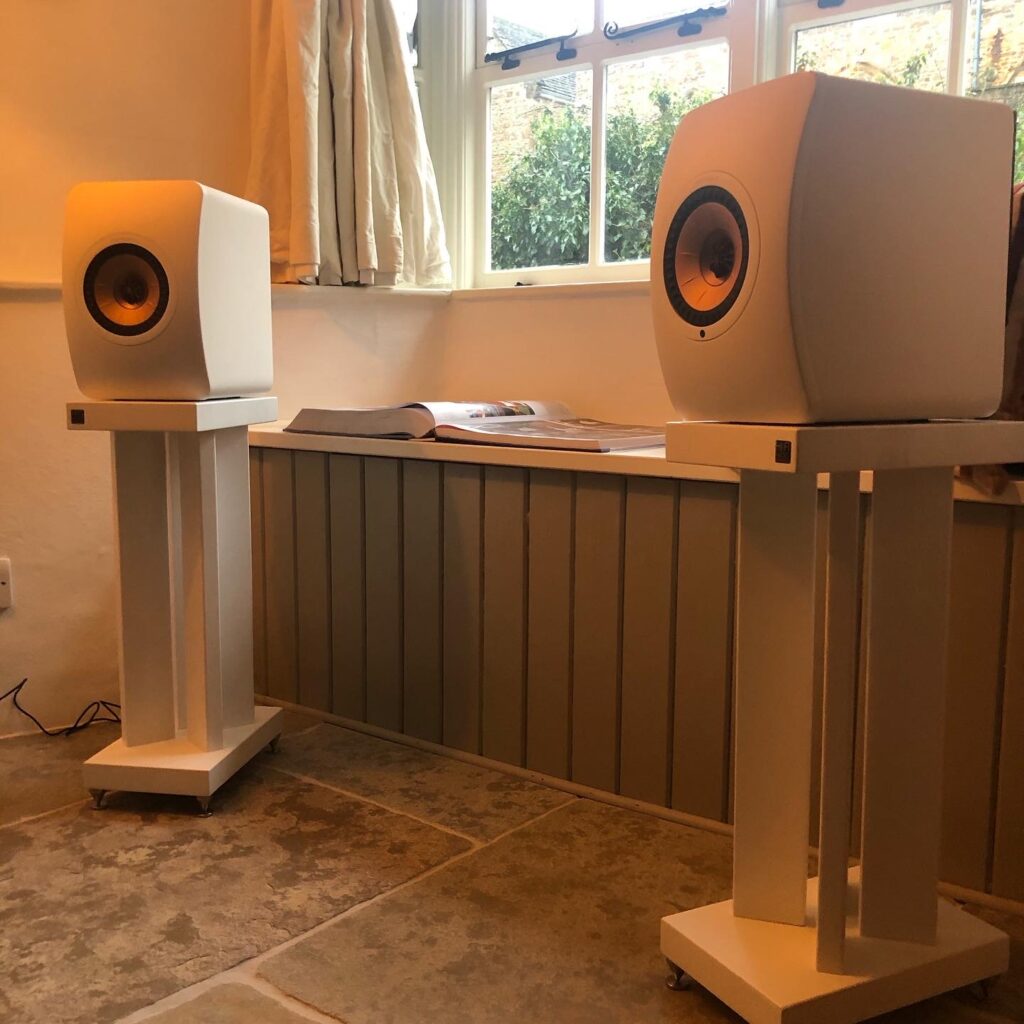
KEF’s LS50 Wireless II on Hi-Fi Racks’ X50 Large stands finished in white satin
Performance
With the Connect app’s EQ options deactivated for Wall and Desk placement modes and the Bass Extension option set to Standard, first impressions are of a wonderful easy-going sound and a seriously impressive soundstage. I’ve spent plenty of time experiencing KEF’s legendary soundstage delivery listening to its designs further up the range on my visits to demo rooms at UK hifi shows, and it’s quite something to achieve a similar experience in terms of a multi-layered stereo soundstage and instantly gratifying musical engagement in my own living room with just a token nod to speaker placement and toe-in.
The room-filling capabilities belie the dimensions of the compact speakers. The soundstage is quite simply incredible with almost tactile imaging and a strong sense of depth that stretches backwards beyond the plane of the speakers. Playing Rudimental’s Spoons (feat. MNEK & Syron), my go-to track for rhythmic engagement and overall bass depth, doesn’t disappoint. The KEFs serve up the track – streamed via Qobuz in CD quality – with plenty of drive as the speakers get into the energy of the track’s repetitive and hooky bass line. Set the Bass Extension mode to Extra and it really gets my toes tapping and as I crank up the volume to an even more lofty volume level, fellow household members are drawn into the room to experience the track close up.

Integrated support for hi-res streaming services including Qobuz, Tidal and Deezer
The KEF’s sonic delivery is entirely in proportion without a sense of any part of its frequency range ever feeling spotlighted or curtailed in any way. The Wireless II has a confident yet relaxed sense of delivery, which is most likely a characteristic of the latest generation design tweaks to its single point source Uni-Q driver array, and I really do get a sense of a perfectly in phase soundwave reaching my ears across all parts of the range.
The Uni-Q and amplifier development tweaks have resulted in a sonic delivery that’s a little more relaxing than the original Wireless, but without giving the feeling that I’m missing out on any part of the audio signal or levels of musical insight. The system has a more finessed treble detail delivery enabling me to listen right into the mix, and I can actually hear that real spoons are being ‘played’ on the Rudimental track.
Hifi credentials
Celebrating its 60th anniversary in 2021, KEF has a world-renowned hifi heritage. Musical insight is part of its DNA, so it’s no surprise that the Wireless II has critical listening credentials too and an innate ability to allow any listener to hear the differences in sound quality between the same tracks streamed via Spotify and Qobuz music services, for example. Inspired by a late-night TV broadcast shown on BBC Four that featured Rod Stewart’s The First Cut is the Deepest, I was reminded to seek out this almost forgotten track. Played via Spotify, the accompanying guitars sound processed and harsh as the streaming service’s mediocre resolution (just 320kbps) is highlighted – the old adage: ‘garbage in, garbage out’ comes to mind as the LS50 does its best to handle the lesser quality of the stream but ultimately reveals just how much information can be lost with low resolution streams. Streaming the same track in CD-quality (around 1,411kbps) via Qobuz reveals just how good this mid-seventies recording can sound, with bags of shimmering detail on the guitar and orchestral strings.
With REL’s S/510 sub-bass system
I’m pretty fanatical when it comes to experiencing the entire frequency range of any recording I listen to and as such, I am a big fan of integrating dedicated sub-bass units into my home hifi setup. So, it’s not surprising that as a reasonably compact standmount speaker design, I occasionally feel that the KEF LS50 Wireless II could do with a little help when it comes to its lower bass delivery.
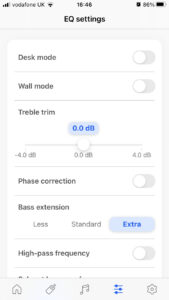
Subwoofer integration settings on Connect app
As previously mentioned in the Setup section, the Wireless II can accommodate a line-level subwoofer and with REL’s S/510 already in place from a previous review, I simply connect the Sub output at the back of the Secondary speaker using a 3m QED coaxial interconnect cable I had to hand and adjust the Sub Settings in the menu to my taste on the KEF Connect app.
It’s a formidable partnership. The bass line to tracks such as Vinyl by Berwyn, Save Your Tears by The Weeknd or Billie Eilish’s Therefore I Am snap into place with the kind of bass energy and engagement that makes the LS50 Wireless II even more of a joy to listen to and the music sings with captivating rhythmic excitement.
In summary
As a proponent of the stereo separates philosophy to building a great-sounding hifi system, I’ve found the LS50 Wireless II to be one of the most enjoyable all-in-one hifi music systems I’ve encountered. Building on the success of it’s the iconic LS50 passive loudspeaker design and original Wireless incarnation, this second-generation Wireless version ups the standards for the domestic active speaker market, combining useful connectivity and ease of use with a powerful musical performance that lives up to the hifi standards associated with the brand. It’s no surprise then that KEF’s LS50 Wireless II active speaker system receives an Editor’s Pick from me at the price.
Website: uk.kef.com



